Health Equity Strategy in Australia: Challenges and Policy Options
VerifiedAdded on 2023/06/10
|10
|3107
|425
Report
AI Summary
This report delves into Australia's health equity strategy, examining the challenges faced, particularly by Aboriginal and Torres Strait Islander communities. It highlights issues such as unequal access to healthcare, discrimination, and the impact of social determinants on health outcomes. The report evaluates the need for government intervention, focusing on the National Aboriginal and Torres Strait Islander Health Plan and its objectives to improve health and well-being. It discusses policy options, including collaborations with various organizations and communities, and assesses the likely benefits of these actions. The report also considers international and national standards, the consultation process involved in developing the strategy, and the importance of addressing social determinants to achieve health equity.

Paraphrase This Document
Need a fresh take? Get an instant paraphrase of this document with our AI Paraphraser
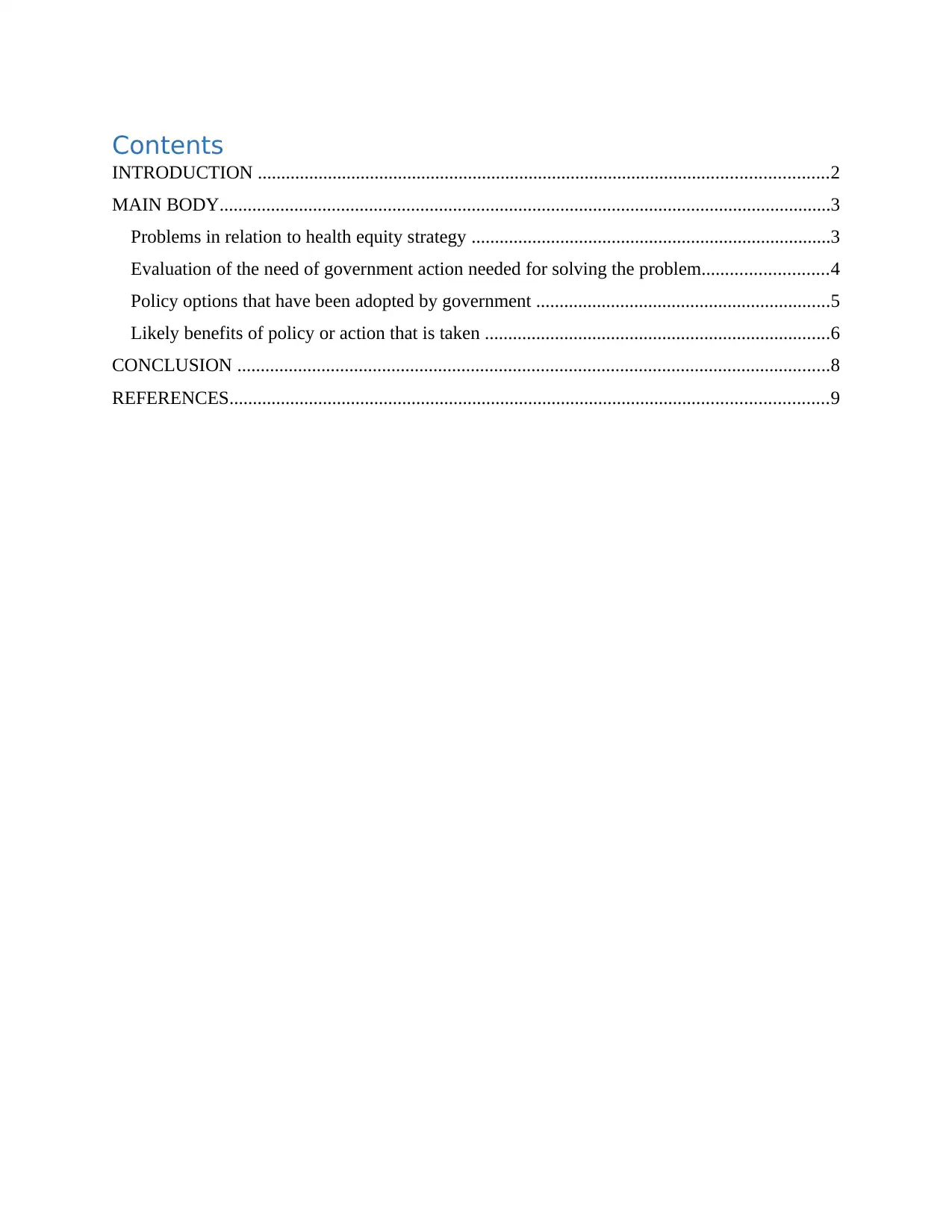
Contents
INTRODUCTION ..........................................................................................................................2
MAIN BODY...................................................................................................................................3
Problems in relation to health equity strategy .............................................................................3
Evaluation of the need of government action needed for solving the problem...........................4
Policy options that have been adopted by government ...............................................................5
Likely benefits of policy or action that is taken ..........................................................................6
CONCLUSION ...............................................................................................................................8
REFERENCES................................................................................................................................9
INTRODUCTION ..........................................................................................................................2
MAIN BODY...................................................................................................................................3
Problems in relation to health equity strategy .............................................................................3
Evaluation of the need of government action needed for solving the problem...........................4
Policy options that have been adopted by government ...............................................................5
Likely benefits of policy or action that is taken ..........................................................................6
CONCLUSION ...............................................................................................................................8
REFERENCES................................................................................................................................9
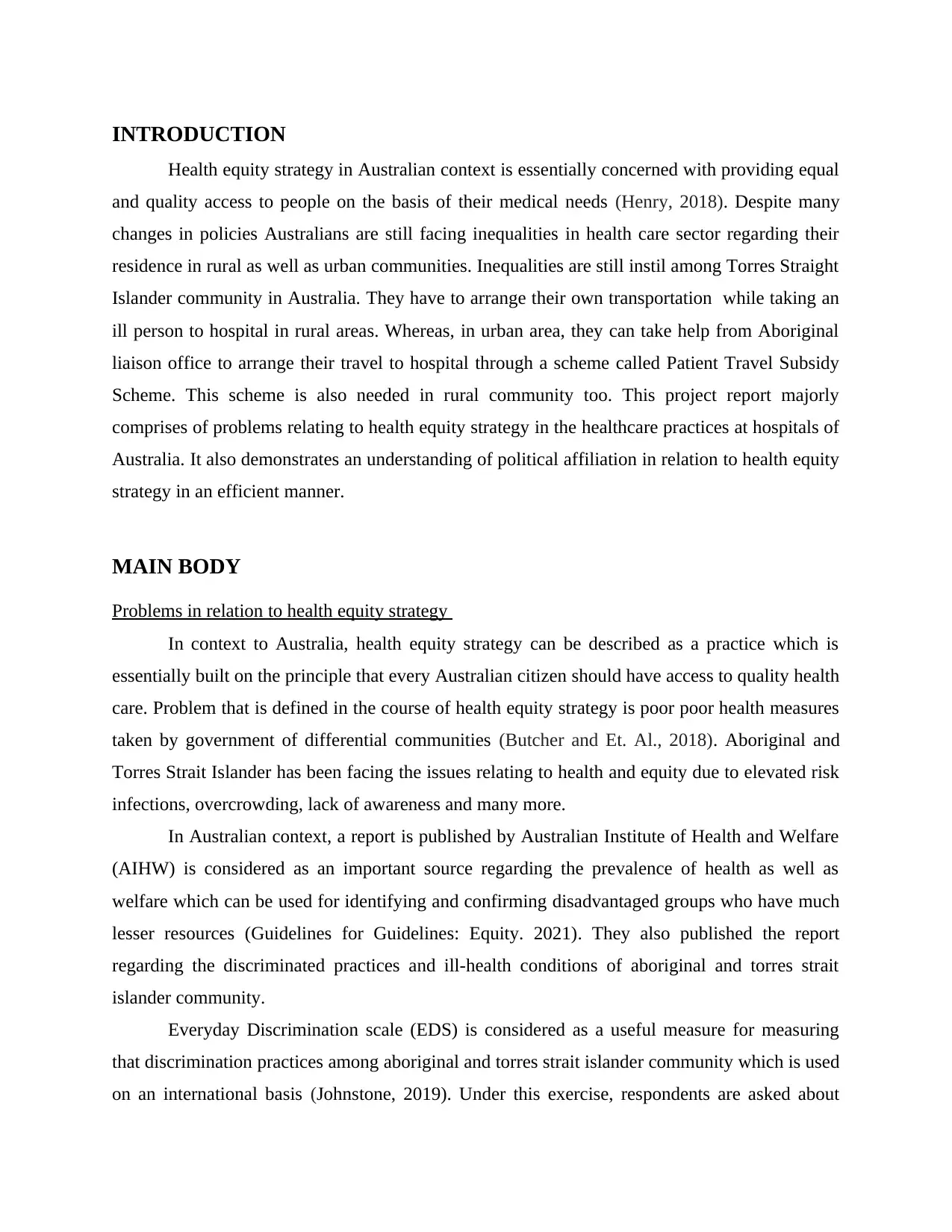
INTRODUCTION
Health equity strategy in Australian context is essentially concerned with providing equal
and quality access to people on the basis of their medical needs (Henry, 2018). Despite many
changes in policies Australians are still facing inequalities in health care sector regarding their
residence in rural as well as urban communities. Inequalities are still instil among Torres Straight
Islander community in Australia. They have to arrange their own transportation while taking an
ill person to hospital in rural areas. Whereas, in urban area, they can take help from Aboriginal
liaison office to arrange their travel to hospital through a scheme called Patient Travel Subsidy
Scheme. This scheme is also needed in rural community too. This project report majorly
comprises of problems relating to health equity strategy in the healthcare practices at hospitals of
Australia. It also demonstrates an understanding of political affiliation in relation to health equity
strategy in an efficient manner.
MAIN BODY
Problems in relation to health equity strategy
In context to Australia, health equity strategy can be described as a practice which is
essentially built on the principle that every Australian citizen should have access to quality health
care. Problem that is defined in the course of health equity strategy is poor poor health measures
taken by government of differential communities (Butcher and Et. Al., 2018). Aboriginal and
Torres Strait Islander has been facing the issues relating to health and equity due to elevated risk
infections, overcrowding, lack of awareness and many more.
In Australian context, a report is published by Australian Institute of Health and Welfare
(AIHW) is considered as an important source regarding the prevalence of health as well as
welfare which can be used for identifying and confirming disadvantaged groups who have much
lesser resources (Guidelines for Guidelines: Equity. 2021). They also published the report
regarding the discriminated practices and ill-health conditions of aboriginal and torres strait
islander community.
Everyday Discrimination scale (EDS) is considered as a useful measure for measuring
that discrimination practices among aboriginal and torres strait islander community which is used
on an international basis (Johnstone, 2019). Under this exercise, respondents are asked about
Health equity strategy in Australian context is essentially concerned with providing equal
and quality access to people on the basis of their medical needs (Henry, 2018). Despite many
changes in policies Australians are still facing inequalities in health care sector regarding their
residence in rural as well as urban communities. Inequalities are still instil among Torres Straight
Islander community in Australia. They have to arrange their own transportation while taking an
ill person to hospital in rural areas. Whereas, in urban area, they can take help from Aboriginal
liaison office to arrange their travel to hospital through a scheme called Patient Travel Subsidy
Scheme. This scheme is also needed in rural community too. This project report majorly
comprises of problems relating to health equity strategy in the healthcare practices at hospitals of
Australia. It also demonstrates an understanding of political affiliation in relation to health equity
strategy in an efficient manner.
MAIN BODY
Problems in relation to health equity strategy
In context to Australia, health equity strategy can be described as a practice which is
essentially built on the principle that every Australian citizen should have access to quality health
care. Problem that is defined in the course of health equity strategy is poor poor health measures
taken by government of differential communities (Butcher and Et. Al., 2018). Aboriginal and
Torres Strait Islander has been facing the issues relating to health and equity due to elevated risk
infections, overcrowding, lack of awareness and many more.
In Australian context, a report is published by Australian Institute of Health and Welfare
(AIHW) is considered as an important source regarding the prevalence of health as well as
welfare which can be used for identifying and confirming disadvantaged groups who have much
lesser resources (Guidelines for Guidelines: Equity. 2021). They also published the report
regarding the discriminated practices and ill-health conditions of aboriginal and torres strait
islander community.
Everyday Discrimination scale (EDS) is considered as a useful measure for measuring
that discrimination practices among aboriginal and torres strait islander community which is used
on an international basis (Johnstone, 2019). Under this exercise, respondents are asked about
⊘ This is a preview!⊘
Do you want full access?
Subscribe today to unlock all pages.

Trusted by 1+ million students worldwide
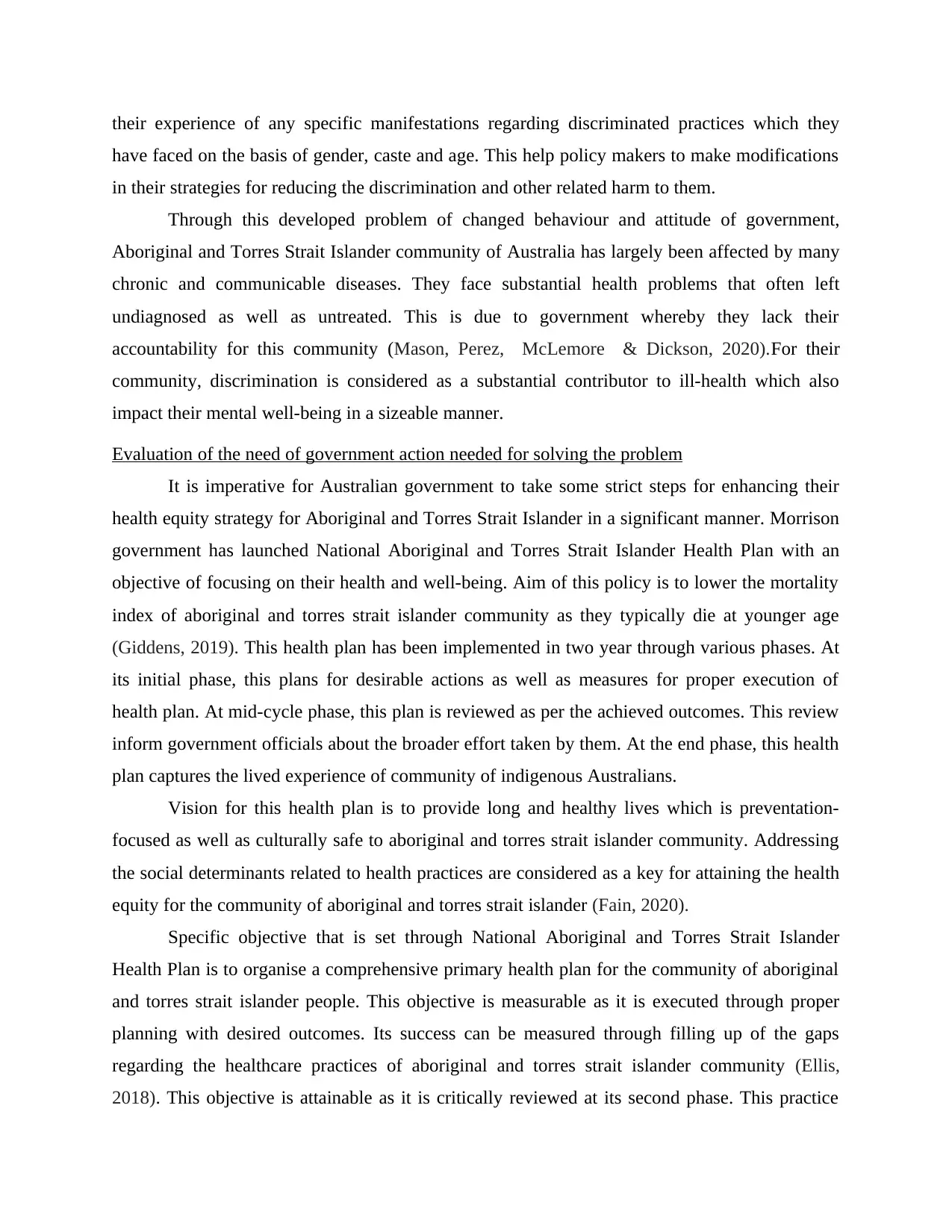
their experience of any specific manifestations regarding discriminated practices which they
have faced on the basis of gender, caste and age. This help policy makers to make modifications
in their strategies for reducing the discrimination and other related harm to them.
Through this developed problem of changed behaviour and attitude of government,
Aboriginal and Torres Strait Islander community of Australia has largely been affected by many
chronic and communicable diseases. They face substantial health problems that often left
undiagnosed as well as untreated. This is due to government whereby they lack their
accountability for this community (Mason, Perez, McLemore & Dickson, 2020).For their
community, discrimination is considered as a substantial contributor to ill-health which also
impact their mental well-being in a sizeable manner.
Evaluation of the need of government action needed for solving the problem
It is imperative for Australian government to take some strict steps for enhancing their
health equity strategy for Aboriginal and Torres Strait Islander in a significant manner. Morrison
government has launched National Aboriginal and Torres Strait Islander Health Plan with an
objective of focusing on their health and well-being. Aim of this policy is to lower the mortality
index of aboriginal and torres strait islander community as they typically die at younger age
(Giddens, 2019). This health plan has been implemented in two year through various phases. At
its initial phase, this plans for desirable actions as well as measures for proper execution of
health plan. At mid-cycle phase, this plan is reviewed as per the achieved outcomes. This review
inform government officials about the broader effort taken by them. At the end phase, this health
plan captures the lived experience of community of indigenous Australians.
Vision for this health plan is to provide long and healthy lives which is preventation-
focused as well as culturally safe to aboriginal and torres strait islander community. Addressing
the social determinants related to health practices are considered as a key for attaining the health
equity for the community of aboriginal and torres strait islander (Fain, 2020).
Specific objective that is set through National Aboriginal and Torres Strait Islander
Health Plan is to organise a comprehensive primary health plan for the community of aboriginal
and torres strait islander people. This objective is measurable as it is executed through proper
planning with desired outcomes. Its success can be measured through filling up of the gaps
regarding the healthcare practices of aboriginal and torres strait islander community (Ellis,
2018). This objective is attainable as it is critically reviewed at its second phase. This practice
have faced on the basis of gender, caste and age. This help policy makers to make modifications
in their strategies for reducing the discrimination and other related harm to them.
Through this developed problem of changed behaviour and attitude of government,
Aboriginal and Torres Strait Islander community of Australia has largely been affected by many
chronic and communicable diseases. They face substantial health problems that often left
undiagnosed as well as untreated. This is due to government whereby they lack their
accountability for this community (Mason, Perez, McLemore & Dickson, 2020).For their
community, discrimination is considered as a substantial contributor to ill-health which also
impact their mental well-being in a sizeable manner.
Evaluation of the need of government action needed for solving the problem
It is imperative for Australian government to take some strict steps for enhancing their
health equity strategy for Aboriginal and Torres Strait Islander in a significant manner. Morrison
government has launched National Aboriginal and Torres Strait Islander Health Plan with an
objective of focusing on their health and well-being. Aim of this policy is to lower the mortality
index of aboriginal and torres strait islander community as they typically die at younger age
(Giddens, 2019). This health plan has been implemented in two year through various phases. At
its initial phase, this plans for desirable actions as well as measures for proper execution of
health plan. At mid-cycle phase, this plan is reviewed as per the achieved outcomes. This review
inform government officials about the broader effort taken by them. At the end phase, this health
plan captures the lived experience of community of indigenous Australians.
Vision for this health plan is to provide long and healthy lives which is preventation-
focused as well as culturally safe to aboriginal and torres strait islander community. Addressing
the social determinants related to health practices are considered as a key for attaining the health
equity for the community of aboriginal and torres strait islander (Fain, 2020).
Specific objective that is set through National Aboriginal and Torres Strait Islander
Health Plan is to organise a comprehensive primary health plan for the community of aboriginal
and torres strait islander people. This objective is measurable as it is executed through proper
planning with desired outcomes. Its success can be measured through filling up of the gaps
regarding the healthcare practices of aboriginal and torres strait islander community (Ellis,
2018). This objective is attainable as it is critically reviewed at its second phase. This practice
Paraphrase This Document
Need a fresh take? Get an instant paraphrase of this document with our AI Paraphraser
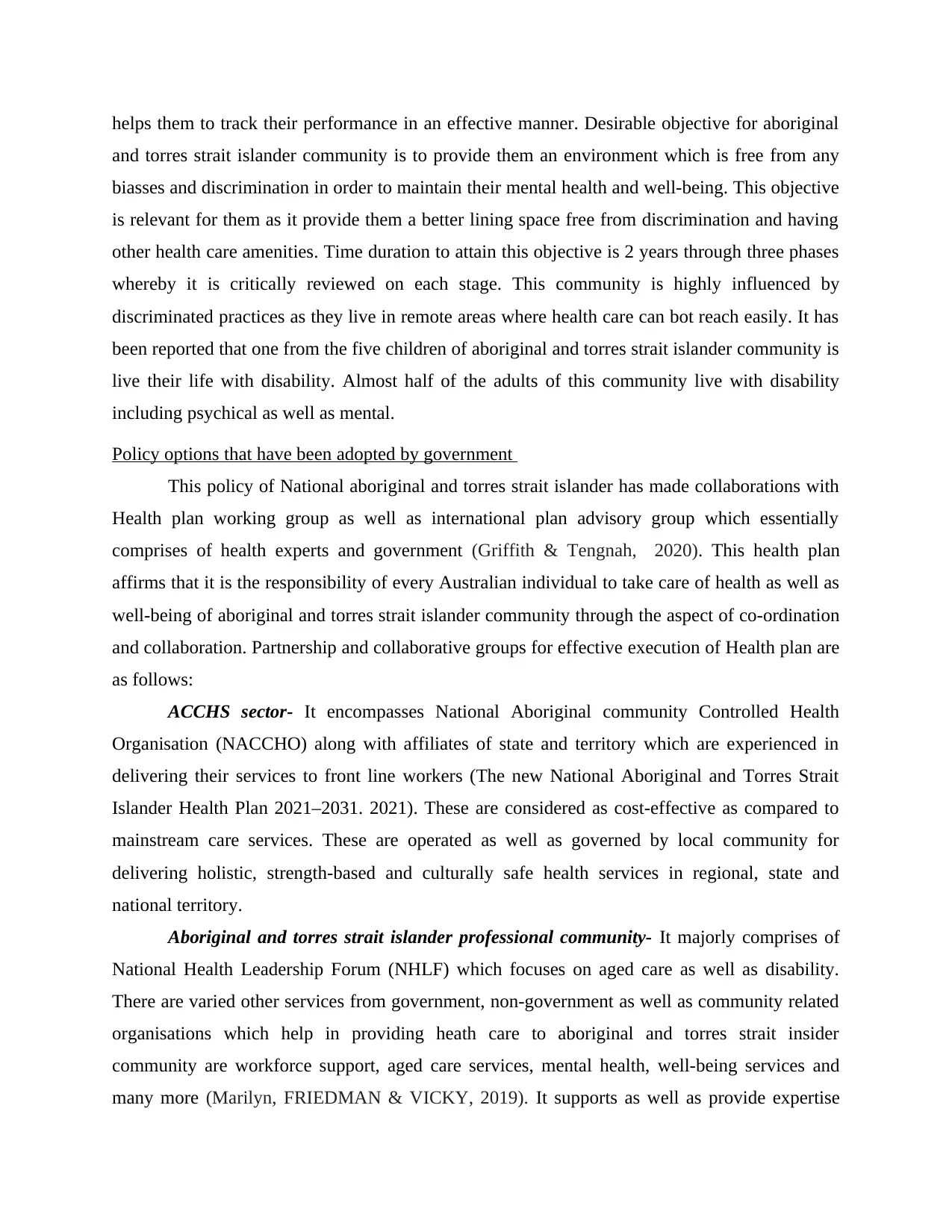
helps them to track their performance in an effective manner. Desirable objective for aboriginal
and torres strait islander community is to provide them an environment which is free from any
biasses and discrimination in order to maintain their mental health and well-being. This objective
is relevant for them as it provide them a better lining space free from discrimination and having
other health care amenities. Time duration to attain this objective is 2 years through three phases
whereby it is critically reviewed on each stage. This community is highly influenced by
discriminated practices as they live in remote areas where health care can bot reach easily. It has
been reported that one from the five children of aboriginal and torres strait islander community is
live their life with disability. Almost half of the adults of this community live with disability
including psychical as well as mental.
Policy options that have been adopted by government
This policy of National aboriginal and torres strait islander has made collaborations with
Health plan working group as well as international plan advisory group which essentially
comprises of health experts and government (Griffith & Tengnah, 2020). This health plan
affirms that it is the responsibility of every Australian individual to take care of health as well as
well-being of aboriginal and torres strait islander community through the aspect of co-ordination
and collaboration. Partnership and collaborative groups for effective execution of Health plan are
as follows:
ACCHS sector- It encompasses National Aboriginal community Controlled Health
Organisation (NACCHO) along with affiliates of state and territory which are experienced in
delivering their services to front line workers (The new National Aboriginal and Torres Strait
Islander Health Plan 2021–2031. 2021). These are considered as cost-effective as compared to
mainstream care services. These are operated as well as governed by local community for
delivering holistic, strength-based and culturally safe health services in regional, state and
national territory.
Aboriginal and torres strait islander professional community- It majorly comprises of
National Health Leadership Forum (NHLF) which focuses on aged care as well as disability.
There are varied other services from government, non-government as well as community related
organisations which help in providing heath care to aboriginal and torres strait insider
community are workforce support, aged care services, mental health, well-being services and
many more (Marilyn, FRIEDMAN & VICKY, 2019). It supports as well as provide expertise
and torres strait islander community is to provide them an environment which is free from any
biasses and discrimination in order to maintain their mental health and well-being. This objective
is relevant for them as it provide them a better lining space free from discrimination and having
other health care amenities. Time duration to attain this objective is 2 years through three phases
whereby it is critically reviewed on each stage. This community is highly influenced by
discriminated practices as they live in remote areas where health care can bot reach easily. It has
been reported that one from the five children of aboriginal and torres strait islander community is
live their life with disability. Almost half of the adults of this community live with disability
including psychical as well as mental.
Policy options that have been adopted by government
This policy of National aboriginal and torres strait islander has made collaborations with
Health plan working group as well as international plan advisory group which essentially
comprises of health experts and government (Griffith & Tengnah, 2020). This health plan
affirms that it is the responsibility of every Australian individual to take care of health as well as
well-being of aboriginal and torres strait islander community through the aspect of co-ordination
and collaboration. Partnership and collaborative groups for effective execution of Health plan are
as follows:
ACCHS sector- It encompasses National Aboriginal community Controlled Health
Organisation (NACCHO) along with affiliates of state and territory which are experienced in
delivering their services to front line workers (The new National Aboriginal and Torres Strait
Islander Health Plan 2021–2031. 2021). These are considered as cost-effective as compared to
mainstream care services. These are operated as well as governed by local community for
delivering holistic, strength-based and culturally safe health services in regional, state and
national territory.
Aboriginal and torres strait islander professional community- It majorly comprises of
National Health Leadership Forum (NHLF) which focuses on aged care as well as disability.
There are varied other services from government, non-government as well as community related
organisations which help in providing heath care to aboriginal and torres strait insider
community are workforce support, aged care services, mental health, well-being services and
many more (Marilyn, FRIEDMAN & VICKY, 2019). It supports as well as provide expertise
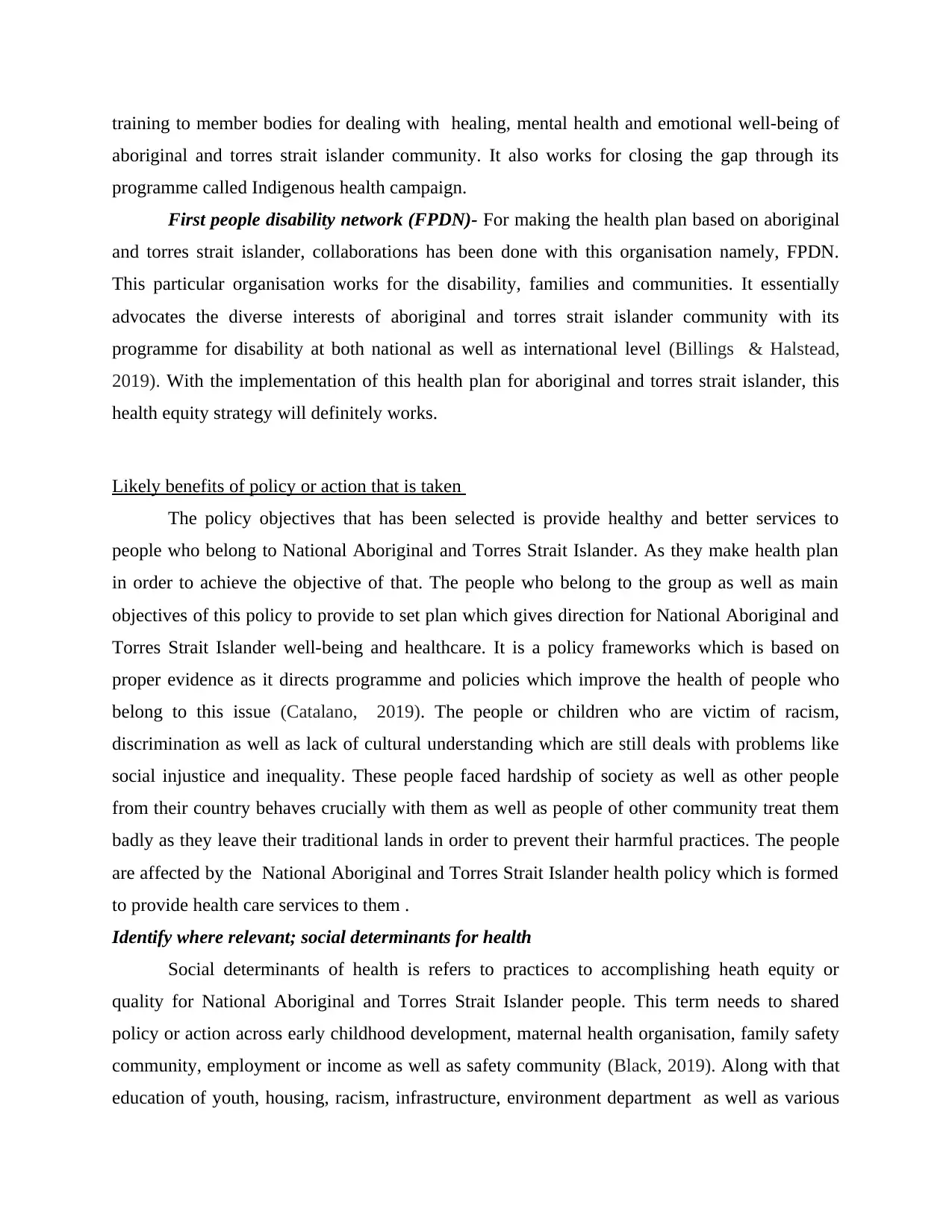
training to member bodies for dealing with healing, mental health and emotional well-being of
aboriginal and torres strait islander community. It also works for closing the gap through its
programme called Indigenous health campaign.
First people disability network (FPDN)- For making the health plan based on aboriginal
and torres strait islander, collaborations has been done with this organisation namely, FPDN.
This particular organisation works for the disability, families and communities. It essentially
advocates the diverse interests of aboriginal and torres strait islander community with its
programme for disability at both national as well as international level (Billings & Halstead,
2019). With the implementation of this health plan for aboriginal and torres strait islander, this
health equity strategy will definitely works.
Likely benefits of policy or action that is taken
The policy objectives that has been selected is provide healthy and better services to
people who belong to National Aboriginal and Torres Strait Islander. As they make health plan
in order to achieve the objective of that. The people who belong to the group as well as main
objectives of this policy to provide to set plan which gives direction for National Aboriginal and
Torres Strait Islander well-being and healthcare. It is a policy frameworks which is based on
proper evidence as it directs programme and policies which improve the health of people who
belong to this issue (Catalano, 2019). The people or children who are victim of racism,
discrimination as well as lack of cultural understanding which are still deals with problems like
social injustice and inequality. These people faced hardship of society as well as other people
from their country behaves crucially with them as well as people of other community treat them
badly as they leave their traditional lands in order to prevent their harmful practices. The people
are affected by the National Aboriginal and Torres Strait Islander health policy which is formed
to provide health care services to them .
Identify where relevant; social determinants for health
Social determinants of health is refers to practices to accomplishing heath equity or
quality for National Aboriginal and Torres Strait Islander people. This term needs to shared
policy or action across early childhood development, maternal health organisation, family safety
community, employment or income as well as safety community (Black, 2019). Along with that
education of youth, housing, racism, infrastructure, environment department as well as various
aboriginal and torres strait islander community. It also works for closing the gap through its
programme called Indigenous health campaign.
First people disability network (FPDN)- For making the health plan based on aboriginal
and torres strait islander, collaborations has been done with this organisation namely, FPDN.
This particular organisation works for the disability, families and communities. It essentially
advocates the diverse interests of aboriginal and torres strait islander community with its
programme for disability at both national as well as international level (Billings & Halstead,
2019). With the implementation of this health plan for aboriginal and torres strait islander, this
health equity strategy will definitely works.
Likely benefits of policy or action that is taken
The policy objectives that has been selected is provide healthy and better services to
people who belong to National Aboriginal and Torres Strait Islander. As they make health plan
in order to achieve the objective of that. The people who belong to the group as well as main
objectives of this policy to provide to set plan which gives direction for National Aboriginal and
Torres Strait Islander well-being and healthcare. It is a policy frameworks which is based on
proper evidence as it directs programme and policies which improve the health of people who
belong to this issue (Catalano, 2019). The people or children who are victim of racism,
discrimination as well as lack of cultural understanding which are still deals with problems like
social injustice and inequality. These people faced hardship of society as well as other people
from their country behaves crucially with them as well as people of other community treat them
badly as they leave their traditional lands in order to prevent their harmful practices. The people
are affected by the National Aboriginal and Torres Strait Islander health policy which is formed
to provide health care services to them .
Identify where relevant; social determinants for health
Social determinants of health is refers to practices to accomplishing heath equity or
quality for National Aboriginal and Torres Strait Islander people. This term needs to shared
policy or action across early childhood development, maternal health organisation, family safety
community, employment or income as well as safety community (Black, 2019). Along with that
education of youth, housing, racism, infrastructure, environment department as well as various
⊘ This is a preview!⊘
Do you want full access?
Subscribe today to unlock all pages.

Trusted by 1+ million students worldwide
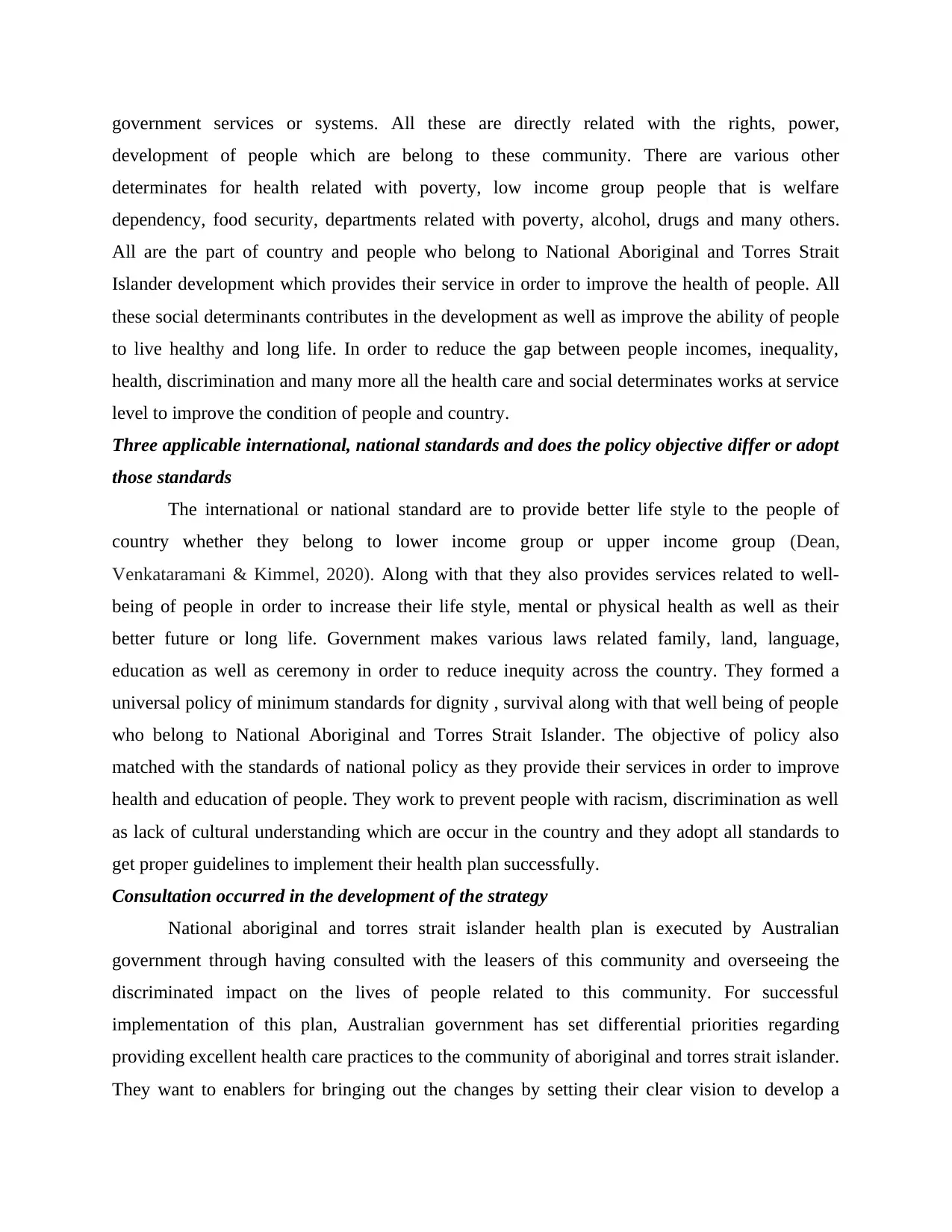
government services or systems. All these are directly related with the rights, power,
development of people which are belong to these community. There are various other
determinates for health related with poverty, low income group people that is welfare
dependency, food security, departments related with poverty, alcohol, drugs and many others.
All are the part of country and people who belong to National Aboriginal and Torres Strait
Islander development which provides their service in order to improve the health of people. All
these social determinants contributes in the development as well as improve the ability of people
to live healthy and long life. In order to reduce the gap between people incomes, inequality,
health, discrimination and many more all the health care and social determinates works at service
level to improve the condition of people and country.
Three applicable international, national standards and does the policy objective differ or adopt
those standards
The international or national standard are to provide better life style to the people of
country whether they belong to lower income group or upper income group (Dean,
Venkataramani & Kimmel, 2020). Along with that they also provides services related to well-
being of people in order to increase their life style, mental or physical health as well as their
better future or long life. Government makes various laws related family, land, language,
education as well as ceremony in order to reduce inequity across the country. They formed a
universal policy of minimum standards for dignity , survival along with that well being of people
who belong to National Aboriginal and Torres Strait Islander. The objective of policy also
matched with the standards of national policy as they provide their services in order to improve
health and education of people. They work to prevent people with racism, discrimination as well
as lack of cultural understanding which are occur in the country and they adopt all standards to
get proper guidelines to implement their health plan successfully.
Consultation occurred in the development of the strategy
National aboriginal and torres strait islander health plan is executed by Australian
government through having consulted with the leasers of this community and overseeing the
discriminated impact on the lives of people related to this community. For successful
implementation of this plan, Australian government has set differential priorities regarding
providing excellent health care practices to the community of aboriginal and torres strait islander.
They want to enablers for bringing out the changes by setting their clear vision to develop a
development of people which are belong to these community. There are various other
determinates for health related with poverty, low income group people that is welfare
dependency, food security, departments related with poverty, alcohol, drugs and many others.
All are the part of country and people who belong to National Aboriginal and Torres Strait
Islander development which provides their service in order to improve the health of people. All
these social determinants contributes in the development as well as improve the ability of people
to live healthy and long life. In order to reduce the gap between people incomes, inequality,
health, discrimination and many more all the health care and social determinates works at service
level to improve the condition of people and country.
Three applicable international, national standards and does the policy objective differ or adopt
those standards
The international or national standard are to provide better life style to the people of
country whether they belong to lower income group or upper income group (Dean,
Venkataramani & Kimmel, 2020). Along with that they also provides services related to well-
being of people in order to increase their life style, mental or physical health as well as their
better future or long life. Government makes various laws related family, land, language,
education as well as ceremony in order to reduce inequity across the country. They formed a
universal policy of minimum standards for dignity , survival along with that well being of people
who belong to National Aboriginal and Torres Strait Islander. The objective of policy also
matched with the standards of national policy as they provide their services in order to improve
health and education of people. They work to prevent people with racism, discrimination as well
as lack of cultural understanding which are occur in the country and they adopt all standards to
get proper guidelines to implement their health plan successfully.
Consultation occurred in the development of the strategy
National aboriginal and torres strait islander health plan is executed by Australian
government through having consulted with the leasers of this community and overseeing the
discriminated impact on the lives of people related to this community. For successful
implementation of this plan, Australian government has set differential priorities regarding
providing excellent health care practices to the community of aboriginal and torres strait islander.
They want to enablers for bringing out the changes by setting their clear vision to develop a
Paraphrase This Document
Need a fresh take? Get an instant paraphrase of this document with our AI Paraphraser
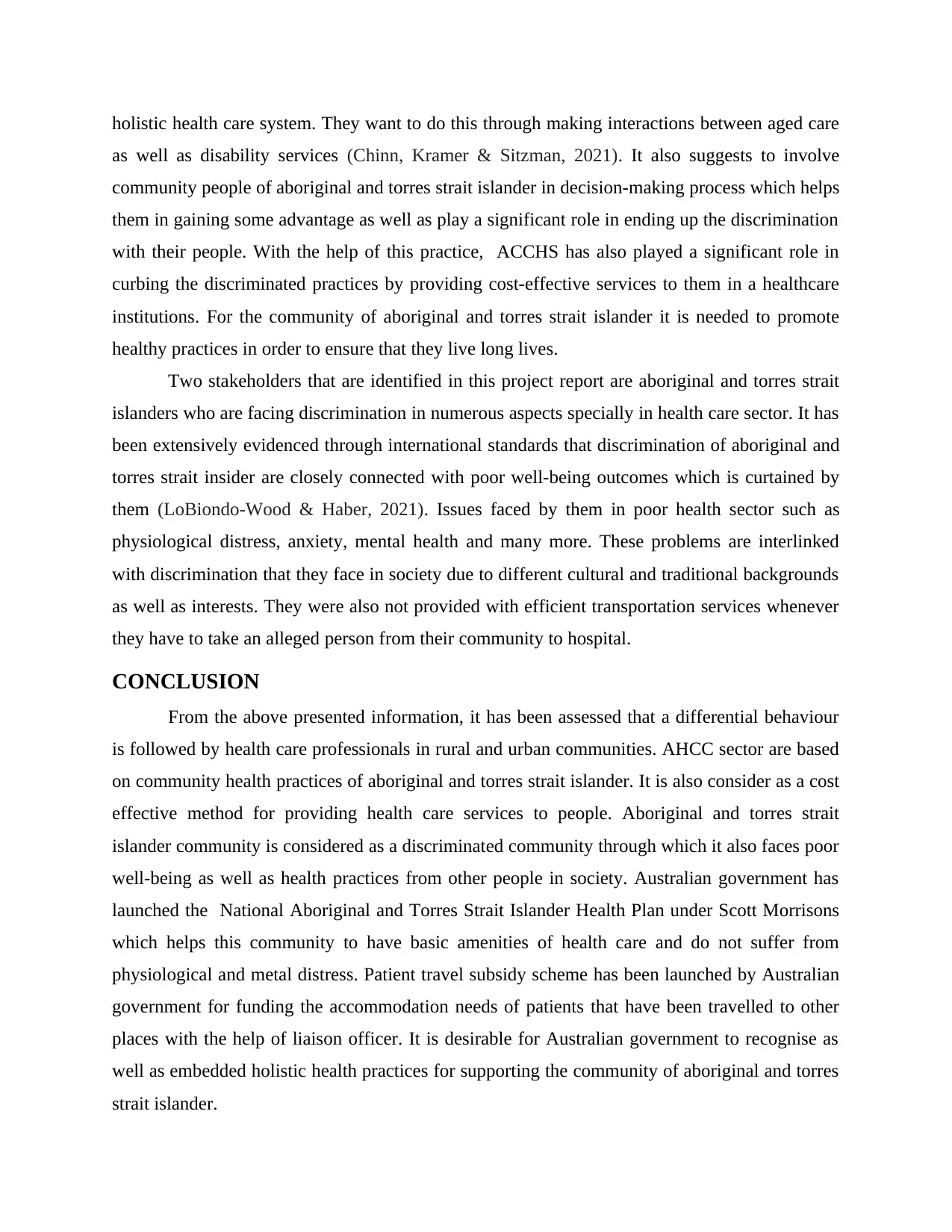
holistic health care system. They want to do this through making interactions between aged care
as well as disability services (Chinn, Kramer & Sitzman, 2021). It also suggests to involve
community people of aboriginal and torres strait islander in decision-making process which helps
them in gaining some advantage as well as play a significant role in ending up the discrimination
with their people. With the help of this practice, ACCHS has also played a significant role in
curbing the discriminated practices by providing cost-effective services to them in a healthcare
institutions. For the community of aboriginal and torres strait islander it is needed to promote
healthy practices in order to ensure that they live long lives.
Two stakeholders that are identified in this project report are aboriginal and torres strait
islanders who are facing discrimination in numerous aspects specially in health care sector. It has
been extensively evidenced through international standards that discrimination of aboriginal and
torres strait insider are closely connected with poor well-being outcomes which is curtained by
them (LoBiondo-Wood & Haber, 2021). Issues faced by them in poor health sector such as
physiological distress, anxiety, mental health and many more. These problems are interlinked
with discrimination that they face in society due to different cultural and traditional backgrounds
as well as interests. They were also not provided with efficient transportation services whenever
they have to take an alleged person from their community to hospital.
CONCLUSION
From the above presented information, it has been assessed that a differential behaviour
is followed by health care professionals in rural and urban communities. AHCC sector are based
on community health practices of aboriginal and torres strait islander. It is also consider as a cost
effective method for providing health care services to people. Aboriginal and torres strait
islander community is considered as a discriminated community through which it also faces poor
well-being as well as health practices from other people in society. Australian government has
launched the National Aboriginal and Torres Strait Islander Health Plan under Scott Morrisons
which helps this community to have basic amenities of health care and do not suffer from
physiological and metal distress. Patient travel subsidy scheme has been launched by Australian
government for funding the accommodation needs of patients that have been travelled to other
places with the help of liaison officer. It is desirable for Australian government to recognise as
well as embedded holistic health practices for supporting the community of aboriginal and torres
strait islander.
as well as disability services (Chinn, Kramer & Sitzman, 2021). It also suggests to involve
community people of aboriginal and torres strait islander in decision-making process which helps
them in gaining some advantage as well as play a significant role in ending up the discrimination
with their people. With the help of this practice, ACCHS has also played a significant role in
curbing the discriminated practices by providing cost-effective services to them in a healthcare
institutions. For the community of aboriginal and torres strait islander it is needed to promote
healthy practices in order to ensure that they live long lives.
Two stakeholders that are identified in this project report are aboriginal and torres strait
islanders who are facing discrimination in numerous aspects specially in health care sector. It has
been extensively evidenced through international standards that discrimination of aboriginal and
torres strait insider are closely connected with poor well-being outcomes which is curtained by
them (LoBiondo-Wood & Haber, 2021). Issues faced by them in poor health sector such as
physiological distress, anxiety, mental health and many more. These problems are interlinked
with discrimination that they face in society due to different cultural and traditional backgrounds
as well as interests. They were also not provided with efficient transportation services whenever
they have to take an alleged person from their community to hospital.
CONCLUSION
From the above presented information, it has been assessed that a differential behaviour
is followed by health care professionals in rural and urban communities. AHCC sector are based
on community health practices of aboriginal and torres strait islander. It is also consider as a cost
effective method for providing health care services to people. Aboriginal and torres strait
islander community is considered as a discriminated community through which it also faces poor
well-being as well as health practices from other people in society. Australian government has
launched the National Aboriginal and Torres Strait Islander Health Plan under Scott Morrisons
which helps this community to have basic amenities of health care and do not suffer from
physiological and metal distress. Patient travel subsidy scheme has been launched by Australian
government for funding the accommodation needs of patients that have been travelled to other
places with the help of liaison officer. It is desirable for Australian government to recognise as
well as embedded holistic health practices for supporting the community of aboriginal and torres
strait islander.

⊘ This is a preview!⊘
Do you want full access?
Subscribe today to unlock all pages.

Trusted by 1+ million students worldwide
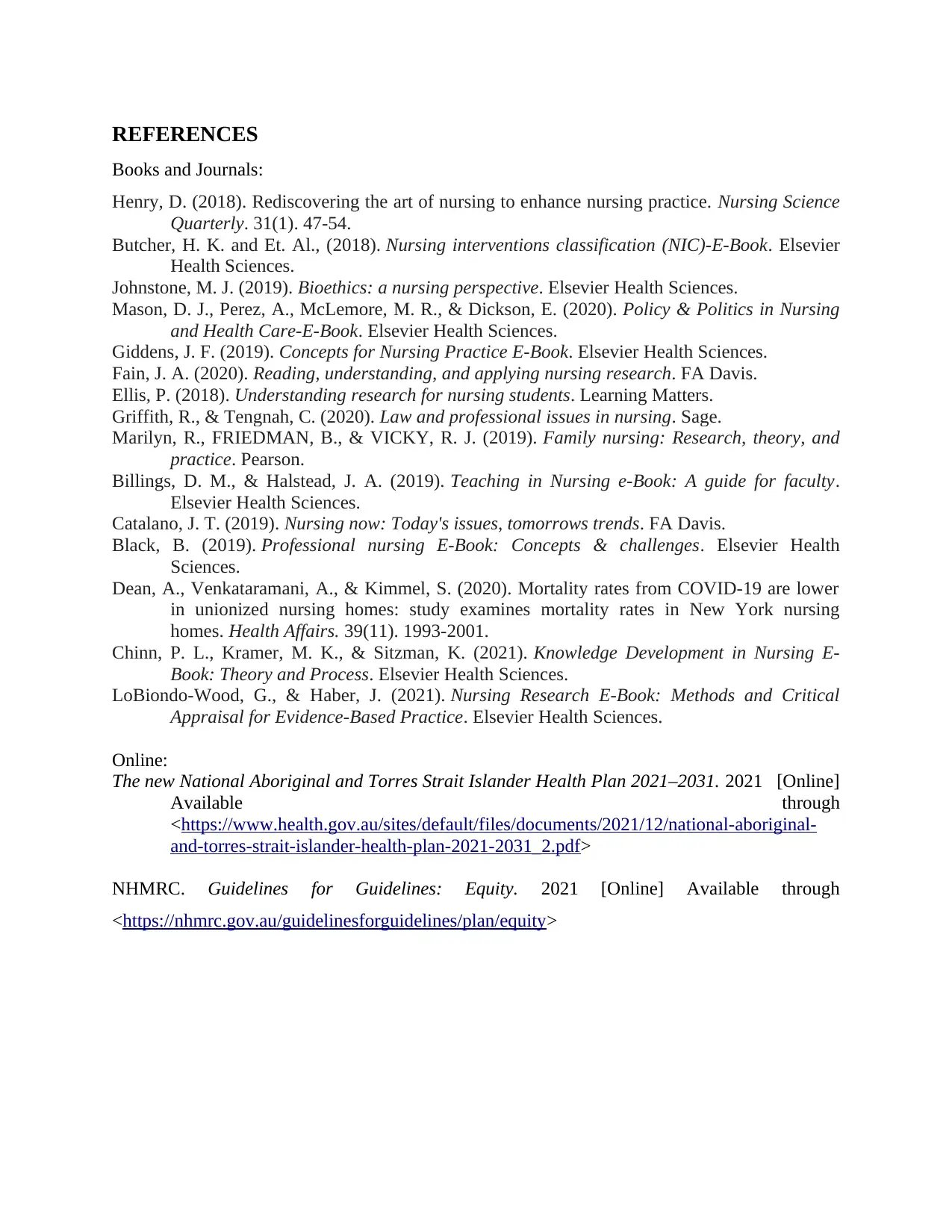
REFERENCES
Books and Journals:
Henry, D. (2018). Rediscovering the art of nursing to enhance nursing practice. Nursing Science
Quarterly. 31(1). 47-54.
Butcher, H. K. and Et. Al., (2018). Nursing interventions classification (NIC)-E-Book. Elsevier
Health Sciences.
Johnstone, M. J. (2019). Bioethics: a nursing perspective. Elsevier Health Sciences.
Mason, D. J., Perez, A., McLemore, M. R., & Dickson, E. (2020). Policy & Politics in Nursing
and Health Care-E-Book. Elsevier Health Sciences.
Giddens, J. F. (2019). Concepts for Nursing Practice E-Book. Elsevier Health Sciences.
Fain, J. A. (2020). Reading, understanding, and applying nursing research. FA Davis.
Ellis, P. (2018). Understanding research for nursing students. Learning Matters.
Griffith, R., & Tengnah, C. (2020). Law and professional issues in nursing. Sage.
Marilyn, R., FRIEDMAN, B., & VICKY, R. J. (2019). Family nursing: Research, theory, and
practice. Pearson.
Billings, D. M., & Halstead, J. A. (2019). Teaching in Nursing e-Book: A guide for faculty.
Elsevier Health Sciences.
Catalano, J. T. (2019). Nursing now: Today's issues, tomorrows trends. FA Davis.
Black, B. (2019). Professional nursing E-Book: Concepts & challenges. Elsevier Health
Sciences.
Dean, A., Venkataramani, A., & Kimmel, S. (2020). Mortality rates from COVID-19 are lower
in unionized nursing homes: study examines mortality rates in New York nursing
homes. Health Affairs. 39(11). 1993-2001.
Chinn, P. L., Kramer, M. K., & Sitzman, K. (2021). Knowledge Development in Nursing E-
Book: Theory and Process. Elsevier Health Sciences.
LoBiondo-Wood, G., & Haber, J. (2021). Nursing Research E-Book: Methods and Critical
Appraisal for Evidence-Based Practice. Elsevier Health Sciences.
Online:
The new National Aboriginal and Torres Strait Islander Health Plan 2021–2031. 2021 [Online]
Available through
<https://www.health.gov.au/sites/default/files/documents/2021/12/national-aboriginal-
and-torres-strait-islander-health-plan-2021-2031_2.pdf>
NHMRC. Guidelines for Guidelines: Equity. 2021 [Online] Available through
<https://nhmrc.gov.au/guidelinesforguidelines/plan/equity>
Books and Journals:
Henry, D. (2018). Rediscovering the art of nursing to enhance nursing practice. Nursing Science
Quarterly. 31(1). 47-54.
Butcher, H. K. and Et. Al., (2018). Nursing interventions classification (NIC)-E-Book. Elsevier
Health Sciences.
Johnstone, M. J. (2019). Bioethics: a nursing perspective. Elsevier Health Sciences.
Mason, D. J., Perez, A., McLemore, M. R., & Dickson, E. (2020). Policy & Politics in Nursing
and Health Care-E-Book. Elsevier Health Sciences.
Giddens, J. F. (2019). Concepts for Nursing Practice E-Book. Elsevier Health Sciences.
Fain, J. A. (2020). Reading, understanding, and applying nursing research. FA Davis.
Ellis, P. (2018). Understanding research for nursing students. Learning Matters.
Griffith, R., & Tengnah, C. (2020). Law and professional issues in nursing. Sage.
Marilyn, R., FRIEDMAN, B., & VICKY, R. J. (2019). Family nursing: Research, theory, and
practice. Pearson.
Billings, D. M., & Halstead, J. A. (2019). Teaching in Nursing e-Book: A guide for faculty.
Elsevier Health Sciences.
Catalano, J. T. (2019). Nursing now: Today's issues, tomorrows trends. FA Davis.
Black, B. (2019). Professional nursing E-Book: Concepts & challenges. Elsevier Health
Sciences.
Dean, A., Venkataramani, A., & Kimmel, S. (2020). Mortality rates from COVID-19 are lower
in unionized nursing homes: study examines mortality rates in New York nursing
homes. Health Affairs. 39(11). 1993-2001.
Chinn, P. L., Kramer, M. K., & Sitzman, K. (2021). Knowledge Development in Nursing E-
Book: Theory and Process. Elsevier Health Sciences.
LoBiondo-Wood, G., & Haber, J. (2021). Nursing Research E-Book: Methods and Critical
Appraisal for Evidence-Based Practice. Elsevier Health Sciences.
Online:
The new National Aboriginal and Torres Strait Islander Health Plan 2021–2031. 2021 [Online]
Available through
<https://www.health.gov.au/sites/default/files/documents/2021/12/national-aboriginal-
and-torres-strait-islander-health-plan-2021-2031_2.pdf>
NHMRC. Guidelines for Guidelines: Equity. 2021 [Online] Available through
<https://nhmrc.gov.au/guidelinesforguidelines/plan/equity>
1 out of 10
Related Documents
Your All-in-One AI-Powered Toolkit for Academic Success.
+13062052269
info@desklib.com
Available 24*7 on WhatsApp / Email
![[object Object]](/_next/static/media/star-bottom.7253800d.svg)
Unlock your academic potential
Copyright © 2020–2025 A2Z Services. All Rights Reserved. Developed and managed by ZUCOL.





